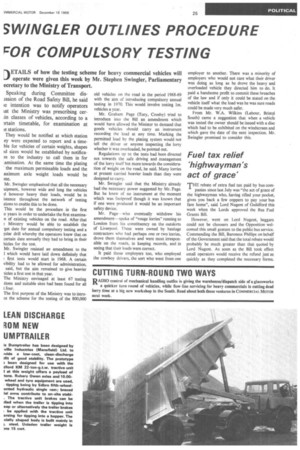5WINGLER OUTLINES PROCEDURE POR COMPULSORY TESTING
Page 27

If you've noticed an error in this article please click here to report it so we can fix it.
DETAILS of how the testing scheme for heavy commercial vehicles will operate were given this week by Mr. Stephen Swingler, Parliamentary ecretary to the Ministry of Transport.
Speaking during Committee disBsion of the Road Safety Bill, he said Le intention was to notify operators Lat. the Ministry was prescribing eertin classes of vehicles, according to a rtain timetable, for examination at le stations.
They would be notified at which station ey were expected to report and a timeble for vehicles of certain weights, shapes id sizes would be established by notifica m to the industry to call them in for :amination. At the same time the plating ' the maximum permissable loads and the aximum axle weight loads would be me.
Mr. Swingler emphasized that all the necessary uipment, however wide and long the vehicles d however heavy their loads, would be in istence throughout the network of testing Mons to enable this to be done.
This would be the procedure in the first o years in order to undertake the first examina n of existing vehicles on the road. After that f. Ministry would be able to establish the .get date for annual compulsory testing and a ;War drill whereby the operators knew that on certain date annually they had to bring in their hides for the test.
Mr. Swingler resisted an amendment to the which would have laid down definitely that first tests would start in 1968. A certain xibility had to be allowed for administration, said, but the aim remained to give heavier lieles a first test in that year.
The Ministry envisaged at least 67 testing itions and suitable sites had been found for all t four.
The first purpose of the Ministry was to introcc the scheme for the testing of the 800,000 old vehicles on the road in the period 1968-69 with the aim of introducing compulsory annual testing in 1970. This would involve testing lm. vehicles a year.
Mr. Graham Page (Tory, Crosby) tried to introduce into the Bill an amendment which would have allowed the Minister to demand that goods vehicles should carry an instrument recording the load at any time. Marking the permitted load by the plating system would not tell the driver or anyone inspecting the lorry whether it was overloaded, he pointed out.
Regulations up to the tests had been directed not towards the safe driving and management of the lorry itself but more towards the consideration of weight on the road, he said. Many lorries at present carried heavier loads than they were designed to carry.
Mr. Swingler said that the Ministry already had the necessary power suggested by Mr. Page. But he knew of no instrument at the moment which was foolproof though it was known that if one were produced it would be an important safety device.
Mr. Page—who eventually withdrew his amendment—spoke of "rouge lorries" finning to London from his constituency on the outskirts of Liverpool. These were owned by haulage contractors who had perhaps one or two lorries, drove them themselves and were most irresponsible on the roads, in keeping records, and in seeing that their loads were correct.
It paid those employers too, who employed the cowboy drivers, the sort who went from one employer to another. There was a minority of employers who would not care what their driver was doing as long as he drove the heavy and overloaded vehicle they directed him to do. It paid a handsome profit to commit these breaches of the law and if only it could be stated on the vehicle itself what the load was he was sure roads could be made very much safer.
From Mr. W.A. Wilkins (Labour, Bristol South) came a suggestion that when a vehicle was tested the owner should be issued with a disc which had to be exhibited on the windscreen and which gave the date of the next inspection. Mr. Swingler promised to consider this.




























































































































